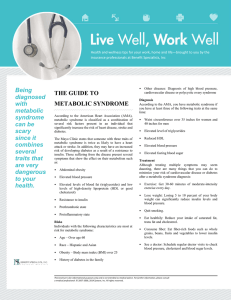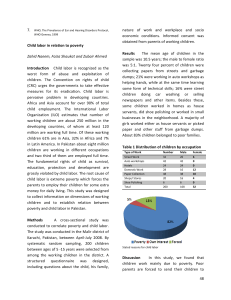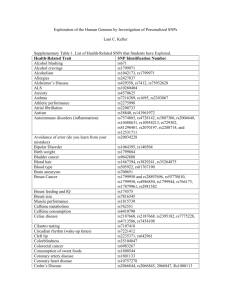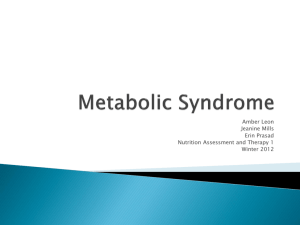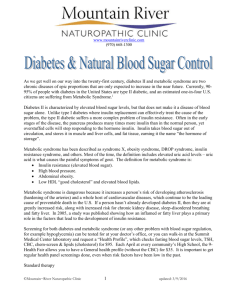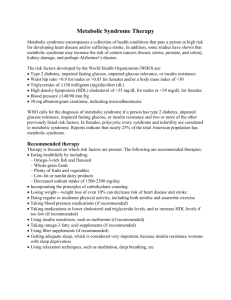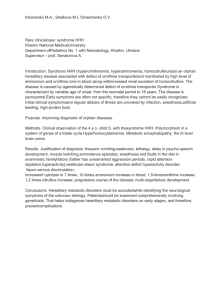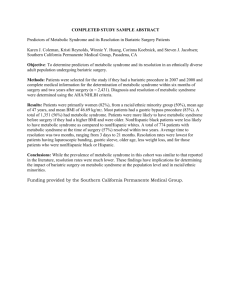Blood sugar and Metabolism – a Weighty Issue
advertisement
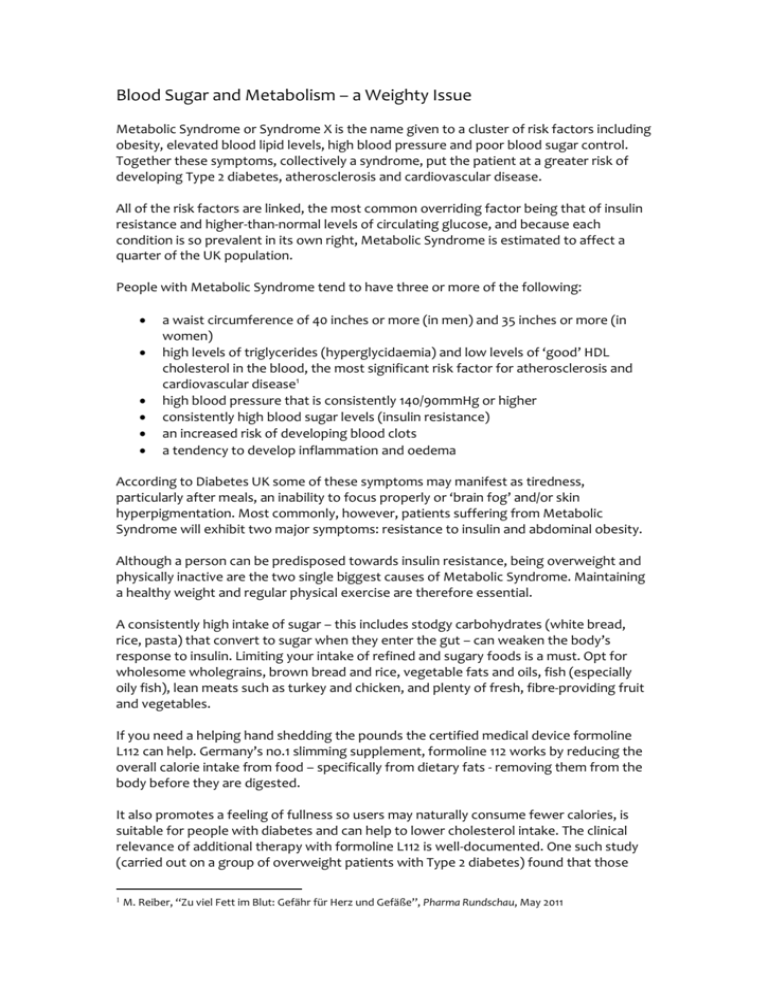
Blood Sugar and Metabolism – a Weighty Issue Metabolic Syndrome or Syndrome X is the name given to a cluster of risk factors including obesity, elevated blood lipid levels, high blood pressure and poor blood sugar control. Together these symptoms, collectively a syndrome, put the patient at a greater risk of developing Type 2 diabetes, atherosclerosis and cardiovascular disease. All of the risk factors are linked, the most common overriding factor being that of insulin resistance and higher-than-normal levels of circulating glucose, and because each condition is so prevalent in its own right, Metabolic Syndrome is estimated to affect a quarter of the UK population. People with Metabolic Syndrome tend to have three or more of the following: a waist circumference of 40 inches or more (in men) and 35 inches or more (in women) high levels of triglycerides (hyperglycidaemia) and low levels of ‘good’ HDL cholesterol in the blood, the most significant risk factor for atherosclerosis and cardiovascular disease1 high blood pressure that is consistently 140/90mmHg or higher consistently high blood sugar levels (insulin resistance) an increased risk of developing blood clots a tendency to develop inflammation and oedema According to Diabetes UK some of these symptoms may manifest as tiredness, particularly after meals, an inability to focus properly or ‘brain fog’ and/or skin hyperpigmentation. Most commonly, however, patients suffering from Metabolic Syndrome will exhibit two major symptoms: resistance to insulin and abdominal obesity. Although a person can be predisposed towards insulin resistance, being overweight and physically inactive are the two single biggest causes of Metabolic Syndrome. Maintaining a healthy weight and regular physical exercise are therefore essential. A consistently high intake of sugar – this includes stodgy carbohydrates (white bread, rice, pasta) that convert to sugar when they enter the gut – can weaken the body’s response to insulin. Limiting your intake of refined and sugary foods is a must. Opt for wholesome wholegrains, brown bread and rice, vegetable fats and oils, fish (especially oily fish), lean meats such as turkey and chicken, and plenty of fresh, fibre-providing fruit and vegetables. If you need a helping hand shedding the pounds the certified medical device formoline L112 can help. Germany’s no.1 slimming supplement, formoline 112 works by reducing the overall calorie intake from food – specifically from dietary fats - removing them from the body before they are digested. It also promotes a feeling of fullness so users may naturally consume fewer calories, is suitable for people with diabetes and can help to lower cholesterol intake. The clinical relevance of additional therapy with formoline L112 is well-documented. One such study (carried out on a group of overweight patients with Type 2 diabetes) found that those 1 M. Reiber, “Zu viel Fett im Blut: Gefähr für Herz und Gefäße”, Pharma Rundschau, May 2011 patients using formoline to lose weight did significantly better than those in the control group. Furthermore, greater improvements in blood glucose, total cholesterol and LDL cholesterol levels were reported in the formoline group2. Increased physical activity and healthy lifestyle choices, such as cutting back on alcohol consumption and stopping smoking, can also help to halt, and in some instances, reverse Metabolic Syndrome. formoline L112 costs £24.95 for 48 tablets and is available from pharmacies and health food shops nationwide, or online at www.healthstuff.co.uk. Call 02890 703100 for your nearest stockist. 2 Otto C, Stoll M, Heitmann C et al.: “Signifikante Gewichtsabnahme unter formoline L112 bei übergewichtigen Typ-2-Diabetikern. Hrsg. Wirth A: formoline-Konzept – Strategie zur Adipositasbehandlung. Neu-Isenburg 2008; 73-92.
